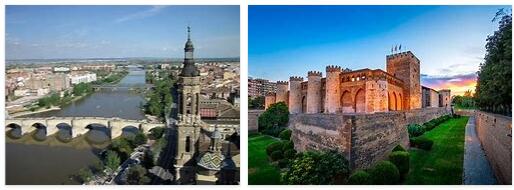Zaragoza, Spain

Zaragoza, Spanish Zaragoza [θara ɣ oθa], capital of the province of Zaragoza, Spain, 200 meters above sea level, economic, cultural and political center of Aragon, in the middle of the Ebro depression, the Ebro, (2020) 681 900 residents.
Metropolitan Catholic Archbishop’s Seat; University (founded in 1542); Messepalast; Theatre; Museums; Gambling casino; Mechanical engineering, automotive, metal, textile, food (including sugar refineries), paper, chemical, pharmaceutical and electrical industries, railway construction, as well as publishing and printing; Garrison. Zaragoza is an important agricultural center and is surrounded by a vega (watered by the Imperial de Aragón Canal and the Ebro, Huerva and Gállego rivers); Tourism; Transport hub on the Barcelona – Bilbao motorway; international airport 10 km west.
Cityscape
Remains of the city walls (2nd century AD) have been preserved from Roman times. The prayer niche (mihrab) of the mosque with a horseshoe-shaped portal testify to the splendor of the former caliph’s palace (»Aljafería«) from the Moorish era (1047–81); the throne room with a magnificent artesonado ceiling (1492) was built under the kings of Aragon. The two most important churches are located near the banks of the Ebro: the Gothic Seo (cathedral, built 1316–1520 on the site of the Moorish main mosque and a Romanesque precursor church, bell tower 1686, main portal 1795) with a northeast brick wall (with azulejos) in Mudejar style and the pilgrimage church Nuestra Señora del Pilar (started in 1681 by F. Herrera the Younger, 1753 by V. Rodríguez Tizón completed, expanded in the 19th and 20th centuries) with a Plateresque main retable by D. Forment (1509–12), dome frescoes from the 18th century by Antonio González Velázquez (* 1729, † 1793), F. de Goyaand F. Bayeu y Subías and the Diocesan Museum (including tapestries from the 14th to 16th centuries). Between the two churches the stock exchange (Lonja) from 1541–51; Palacio de Lara (16th century); seven-arched bridge over the Ebro Puente de Piedra (15th century). Several buildings from the Modernism period around 1900 have been preserved, including: the Casa Juncosa and Casa Molins, the Casino Mercantil, the Edificio de la calle Prudencio, the Quiosco de la Música. Among the more recent buildings, the Museo Pablo Serrano and the Auditorium – Palacio de Congresos (both 1994) are particularly noteworthy. In 2003 the new “Delicias” station was completed. In the course of the world exhibition EXPO, which took place in Zaragoza in 2008, numerous construction and renovation measures were carried out in the city. This also includes the 78 m high Torre del Agua (water tower) by Enrique de Teresa (* 1949).
History
Saragossa, originally the Iberian Salduba, became a Roman veterans’ colony under Augustus as Caesar | augusta; probably around 250 bishopric, 380 council place. The city was conquered in 409 by the Vandal, 452 by the Swebians, 476 by the Visigoths and 712 by the Arabs. The Arab Medina Sarakosta flourished through the planting of the Vega and various arts and crafts (carpets, silk crafts) and received many splendid buildings; From 1039 to 1110 it was the capital of a taifa. 1118 by Alfons I. recaptured, Saragossa was the capital of Aragon until the court was moved to Castile (1479). In 1318 it became the seat of the archbishop. In the 16th century, Zaragoza flourished again with the establishment of the university (1542, from the Art Academy of 1474) and its silk products. 1808-09 it was conquered by the French after losing resistance; In 1838 the invading Carlist were expelled.
On April 22nd, 1529 between Emperor Karl V and Johann III. Portugal signed the Treaty of Saragossa (story of the discovery).
Cabrera
Cabrera, island of the Balearic Islands, Spain, about 15 km south of Mallorca, 15.7 km 2; mountainous; hardly populated; Nature reserve; prehistoric cave, Arab fortress ruins, coasts rich in fish. Ferry connection with Palma de Mallorca.
Ibiza
Ibiza [i iθa], Catalan Eivissa [əi visə] main island of Ibiza and Formentera and third largest island of the Balearic Islands (Spain), 568 km 2 in size, 106 200 residents;consists of two ridges made of Mesozoic limestone layers (highest point: Sa Talaissa, 475 m above sea level; southwest of Sant Josep de sa Talaia) and has mainly steep coasts with individual bathing bays, only in the south flat alluvial land with salt gardens. Hamlets and individual farms with extensive irrigation crops (melons, strawberries, potatoes) and fruit groves. The most important branch of the economy is tourism. Export of fish and lobsters, olives, figs, canned fruit, carob, sea salt; Passenger ferries to Formentera, Palma de Mallorca, Barcelona, Valencia, Dénia; international Airport. The island has been declared a World Cultural and Natural Heritage Site by UNESCO because of its biological diversity and culture.
Formentera
Formentera, island of the Balearic Islands, Spain, 18 km south of Ibiza in the Pityusen group, 115 km 2, 7,100 residents; consists of two limestone blocks with long beaches in front of them (highest mountain La Mola, 192 m above sea level, lighthouse). Formentera has poor vegetation (garigue), modest grain, wine and potato cultivation, windmills, sea salt production, fishing (tuna) and tourism. The main town is Sant Francesc de Formentera with a fortified church (1738).